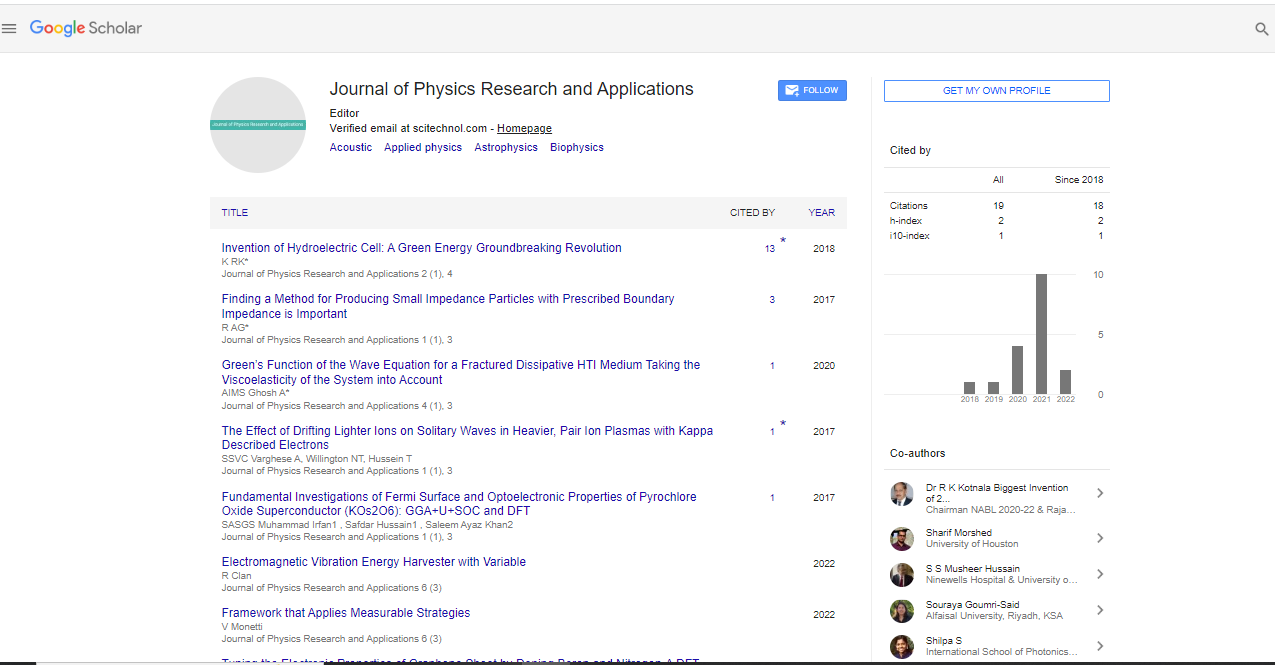Commentary, J Phys Res Appl Vol: 8 Issue: 4
The Role of Geophysics in Understanding Ocean Dynamics
Mary Joseph*
1Department of Physics, University of Texas, Texas, USA
*Corresponding Author: Mary Joseph,
Department of Physics, University of Texas,
Texas, USA
E-mail: mary@jsph.org
Received: 19 November, 2024, Manuscript No. JPRA-24-156498;
Editor assigned: 21 November, 2024, PreQC No. JPRA-24-156498 (PQ);
Reviewed: 06 December, 2024, QC No. JPRA-24-156498;
Revised: 13 December, 2024, Manuscript No. JPRA-24-156498 (R);
Published: 20 December, 2024, DOI: 10.4172/JPRA.1000127.
Citation: Joseph M (2024) The Role of Geophysics in Understanding Ocean Dynamics. J Phys Res Appl 8:4.
Description
Geophysics is the study of the Earth's physical properties and processes which plays an essential role in understanding ocean dynamics. Oceans, covering over 70% of the Earth’s surface, are not only contributes in the planet's climate and weather systems but also to global ecosystems and human activities. The interaction between the ocean and the Earth's crust, mantle and atmosphere is complex and geophysical techniques provide invaluable tools to study these interactions. Through methods such as seismic imaging, satellite altimetry, magnetic surveys and ocean floor mapping. One of the most important aspects of ocean dynamics is ocean circulation, which includes both surface currents and deep-water currents. These currents play an essential role in regulating Earth’s climate by redistributing heat and nutrients around the globe.
Geophysical tools help track and measure these currents. Satellite altimetry, for example, uses radar waves to measure the surface topography of the ocean. By measuring sea surface height, scientists can detect ocean currents, waves. Changes in sea level due to ocean circulation also provide insights into global warming and the melting of polar ice caps. Furthermore, geophysics helps map the underlying processes of these currents. Through seismic profiling and ocean floor mapping, scientists can understand how features such as the midocean ridges, deep-sea trenches and underwater mountains influence ocean circulation patterns. These geophysical techniques reveal how the Earth's crust shapes ocean currents and their ability to store and transfer heat, which is essential for understanding long-term climate changes. Geophysics plays a significant role in mapping the ocean floor, which is essential for understanding both ocean dynamics and plate tectonics. The ocean floor is the site of various geological processes, such as seafloor spreading, subduction and volcanic activity, which directly impact ocean circulation and ecosystems.
Seismic reflection and refraction techniques are widely used to map the ocean floor and study its structure. These techniques involve sending sound waves into the ocean and measuring the time it takes for them to bounce back from the seabed. This data allows scientists to create detailed maps of underwater features, such as mid-ocean ridges, continental slopes and deep-sea trenches. By studying these features, geophysicists can better understand how the movement of tectonic plates influences ocean dynamics, including the formation of ocean basins, oceanic ridges and the distribution of ocean currents.
In addition, magnetic surveys are used to study the Earth's magnetic field and how it interacts with the ocean floor. The magnetic anomalies detected in the ocean floor are a result of seafloor spreading at divergent plate boundaries. This interaction between Earth's magnetic field and oceanic crust provides understanding into the rates of seafloor spreading, which impacts ocean basin formation and the distribution of marine resources. Submarine volcanic eruptions release heat and gases into the ocean, influencing water temperature and local ocean circulation patterns. By studying the seismic waves generated by these volcanic events, scientists can gain information about the subsurface structure of the ocean floor, including the nature of magma chambers and volcanic vents. Seismic tomography, which uses seismic waves to create detailed images of subsurface structures, is instrumental in understanding the dynamics of submarine volcanism and its interaction with ocean currents. Earthquakes that occur along subduction zones or transform faults beneath the ocean floor can also lead to the formation of tsunamis, which are large, fast-moving waves that can devastate coastal communities. Geophysics helps in monitoring seismic activity and earthquake-induced sea-level changes, allowing for the development of early warning systems for tsunami prediction.
 Spanish
Spanish  Chinese
Chinese  Russian
Russian  German
German  French
French  Japanese
Japanese  Portuguese
Portuguese  Hindi
Hindi 
